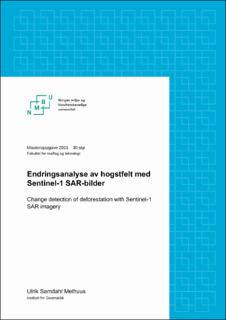| dc.contributor.advisor | Maalen-Johansen, Ivar | |
| dc.contributor.advisor | Rostad, Stian | |
| dc.contributor.advisor | Groesz, Floris Jan | |
| dc.contributor.author | Melhuus, Ulrik Samdahl | |
| dc.coverage.spatial | Norway, Akershus, Aurskog-Høland | en_US |
| dc.date.accessioned | 2021-10-19T13:17:06Z | |
| dc.date.available | 2021-10-19T13:17:06Z | |
| dc.date.issued | 2021 | |
| dc.identifier.uri | https://hdl.handle.net/11250/2823924 | |
| dc.description.abstract | Kartlegging av vegetasjon med Sentinel-2 multispektrale bildesatellitter er velrenommert, og mye brukt den dag i dag. Fordi Sentinel-2 er en bildesatellitt krever den klar sikt til bakken med tilstrekkelig sollys for å tydelig detektere jordoverflaten. Forholdene og årstidene i Norge byr på sine utfordringer med mye skydekke, mørketid og snødekke store deler av året.
I denne oppgaven er endringsanalyse på VV- og VH-polariserte bilder fra Sentinel-1 SAR forsøkt med objekt klassifisering. Forsøket går ut på å se om Sentinel-1 kan utføre endringsanalyse på vintersesongen, da Sentinel-2 multispektrale bilder ikke kan brukes til kartlegging grunnet snødekke. Klassifiseringen er gjort med tre forskjellige algoritmer, Tilfeldig treutvalg (RFC), Støttevektormaskin (SVM) og Nærmeste nabo (KNN).
Området betraktet i oppgaven er skogkommunen Aurskog-Høland. Trenings-/testdatasettet kommer fra endringsanalyse utført med U-Net "deep learning" på Sentinel-2 bilder, levert av Blom oppgaven skrives for. Treningsdatasettet består av totalt 356 hogstflater felt mellom sommeren- 2019 og 2020. Bare hogstflatene felt mellom oktober 2019 og april 2020 er tatt med i oppgaven for å se om endringer på vintersesong kan detekteres med SAR-bilder. Klassifiseringen er utført med binært utvalg som er skog- eller hogstflate. Datasettet brukt i oppgaven består totalt av 130 hogstpolygoner og 77 skogpolygoner. En middelverdi av hvert polygon på alle SAR-bildene brukes som trenings- og testdata i klassifisering.
Det er tre datasett som testes separat. Datasett en består av SAR-bilder før og etter vintersesongen, altså før og etter hogst på hogstflatene tatt til betrakting i oppgaven. Datasett to består av SAR-bilder før og vintersesongen, altså før og under tiden hogsten i oppgaven er utført. Datasett tre er samme tidspunkt som datasett to, men med bare VH-polarisering. En enkel pikselklassifisering er utført med alle maskinlæringene trent opp på objektklassifiseringene utført på polygonene.
Resultatene med SVM på datasett en og to var så å si helt like med f1-tall på 87,3%. Resultatene samlet indikerer at SAR har tilstrekkelig med informasjon til å detektere endringer i skogområder. Bildeklassifiseringen viser også med Sentinel-1 klarer maskinlæringene å skille ut store deler av hogstene i et utvalgt studieområde. Konklusjonen er at Sentinel-1 har et mulig bruksområde for skogovervåking i Norge, men dette krever videre arbeid. | en_US |
| dc.description.abstract | Vegetation mapping with Sentinel-2 multispectral image satellites is reputable and widely used to this day. Because Sentinel-2 is an imaging satellite, it requires a clear view of the ground with sufficient sunlight to detect the earth's surface. The conditions and seasons in Norway offer their challenges with a lot of cloud cover, dark time, and snow cover most of the year.
This thesis attempts to apply a change detection with VV- and VH-polarized images from Sentinel-1 SAR, with object-orientated classification. The experiment examined whether Sentinel-1 can perform change analysis during the winter season, as Sentinel-2 multispectral images can not deliver mapping due to snow cover. Three di_erent classi_cations were used, Random Forest Classifier (RFC), Support Vector Machine (SVM), and K-Nearest Neighbor (KNN).
The area considered in the thesis is the forest municipality Aurskog-Høland. The training/test dataset comes from change analysis performed with U-Net “deep learning" on Sentinel-2 images, provided by Blom, for whom the thesis was written. The training data set consists of 356 harvested fields between the summer of 2019 and 2020. Only the harvested fields between October 2019 and April 2020 are included in the task to see if changes in the winter season could be done with SAR images. The classi_cations including a binary sample, forest, or deforested area. The dataset used in the thesis consists of a total of 130 deforestation polygons and 77 forest polygons. The raining and test data consist of a median value taken from each polygon on all SAR images.
Three data sets were separately tested. Dataset one consists of SAR images before and after the winter season, which means before and after the deforestations used in this thesis took place. Dataset two consists of SAR images before and during the winter season, which means before and during deforestation. Data set three uses the exact measurements as data set two but with only VH- polarization. As well as object classi_cation, a simple pixel classification with all the machine learning algorithms was tested to output classified images.
The results with SVM on data sets one and two were almost the same with f1 numbers of 87.3 %. The overall results indicate that SAR has sufficient information to detect changes in forest areas. The image classification also shows that with Sentinel-1, machine learning can distinguish large parts of the harvests in a selected study area. The conclusion is that Sentinel-1 can be used in forest monitoring in Norway, but this requires further work. | en_US |
| dc.language.iso | nob | en_US |
| dc.publisher | Norwegian University of Life Sciences, Ås | en_US |
| dc.rights | Attribution-NonCommercial-NoDerivatives 4.0 Internasjonal | * |
| dc.rights.uri | http://creativecommons.org/licenses/by-nc-nd/4.0/deed.no | * |
| dc.title | Endringsanalyse av hogstfelt med Sentinel-1 SAR-bilder | en_US |
| dc.title.alternative | Change detection of deforestation with Sentinel-1 SAR imagery | en_US |
| dc.type | Master thesis | en_US |
| dc.description.localcode | M-GEOM | en_US |

